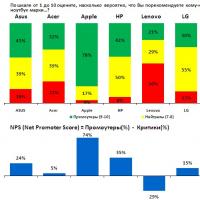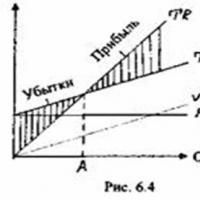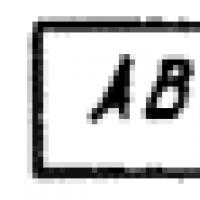Cognitive lesson in the second younger group of birds. Lesson notes for the junior group "birds". Check out a fragment of the theme week
Luda Kuznetsova
Summary of the final lesson in the second younger group on the theme "Birds"
Summary of the final lesson
in second younger group
"Wild and Domestic" birds»
Made up
teacher
I qualification category:
Kuznetsova L. S.
Konosha village
Target: consolidation of knowledge about birds.
Tasks:
Educational objectives:
To develop the ability for dialogical speech and onomatopoeia of voices birds.
Learn to name and distinguish between domestic and wild birds; exercise children in comparison and classification birds;
Developmental tasks:
Develop the ability to solve riddles; learn birds by voice.
Develop curiosity and educational interests.
Educational tasks:
Cultivating a caring attitude towards birds;
Equipment: cards depicting domestic and wild birds, audio recordings of voices birds, nest, chest, doll, letter, bus, audio recording "Bibika", "Song of Friends", "Voices of the Forest", audio recording of household voices birds.
Preliminary work: singing recording birds, reading stories, fairy tales and poems about birds, selection of riddles about birds.
Progress of the lesson.
Educator: We have something interesting today class which your parents came to see. But first, let's greet our hands, feet, eyes, cheeks...
Greetings
Hello pens clap, clap, clap
Hello, legs top, top, top
Hello, cheeks splash, splash, splash
Hello, eyes clap, clap, clap
Hello sponges (pull 3 times)
Hello, my nose is bi, bi, bi
Hello everyone, hello everyone!
Educator: Well done, everyone was greeted, everyone good mood. Guys, when I was going to work today, a white-sided magpie flew up to me and handed me a letter for you. Let's see what's in it?
Text of the letter:
"Dear Guys! I am Spring - red! The evil Baba Yaga bewitched me. She hid me behind six locks in a chest in a dense forest, so it’s still cold outside, the sun isn’t shining and the birds aren’t singing... I’m waiting for you guys in the fairytale forest. Help me. To help me you need to complete all of Baba Yaga’s tasks.”
Educator: How will we guys go to the fairytale forest?
Children: by bus.
Educator: Of course, guys, on the magic bus. Hurry up, get in it and let's go...
An excerpt from a song is played "Bibika"
Educator: So you and I found ourselves in a fairytale forest. Our bus stopped at a magical clearing and it’s called "Glade of Mysteries". Baba Yaga left us an envelope with riddles, but I’ll tell you a secret that you can find the answers on these wonderful trees...
Riddles from Baba Yaga
He chirps and jumps
It looks like a gray ball
Asks children for crumbs... (Sparrow)
I won't miss what glitters
I drag everything into my nest.
Blacktail, white-sided.
Did you guess it? I - (magpie).
Whose breast is brighter than the dawn? (Bullfinch).
And whistles and rattles.
Forest birds are small
Yellow-breasted... (Titmouse)
Color – grayish,
Habit - thieving,
Hoarse screamer,
Famous person.
Who is she?. (Crow)
In a red hat the bird walks.
And he finds beetles in the bark.
This is an old friend of mine.
And it's called a bird.
(Woodpecker)
Educator: Well done guys, you coped with such a difficult task and for this B. Ya. left us a key and we can now open the first lock on our chest. (I open 1 lock)
The phonogram sounds "Song of Friends"
Educator: Here is the next clearing in which we will look for the key.
Look what B.Y. hid under the tree - masks birds. B.Ya. doesn’t want us to help Vesna, he wants to bewitch us and turn us into ravens, but don’t be afraid, kids, we’ll play a game first "The Crows and the Little Dog", and then I will say the magic words and we will become children again. Do you agree? (The game is played 2 times)
1,2,3 – turn around and turn into a kid. And here the key was found. You hurry up and get on the bus, and I'll open the door second lock and you and I will move on...
The phonogram sounds "Bibika"
Educator: Our next stop is at the clearing "Rainbow - Arc".
Listen, is someone crying? Oh, it's a cockerel. Again B. I tried and bewitched poor Cockerel’s tail, but it’s okay - we can cope with this task. I have some magic feathers. Each of you takes a feather, says what color it is and gives it to the Cockerel.
The phonogram sounds "The Sound of the Rooster"
The cockerel really liked our feathers, and he thanked us, and he also gave me the key to the chest. Let's continue on our way...
The phonogram sounds "Song of Friends"
Educator: Guys, I’m really tired. It's time for us to rest. Stand in a circle and let's play.
Physical education minute:
Birds jump, fly, birds sing merrily,
Birds collect crumbs, birds peck grains.
The feathers were cleaned, the beaks were cleaned,
The phonogram sounds "Bibika"
Educator: What do we have here? Polyanka "Guess - ka".
How to find out bird? What do you have birds? (Wings). That's right, y birds have wings. How many are there? (two). For what bird wings? (To fly). What else do you have birds? (Paws). How many are there? (Two). For what bird paws? (Walk, jump on the ground). What is the body covered with? birds? (Feathers). What's on your head birds What is she biting with? (Beak).
Description birds by model
Educator: Please tell me guys where they live birds?
Children: In the forest.
Educator: Right. What kind of people live in the forest? birds?
Children: Wild.
Educator: And where do they live? birds?
Children: Houses.
Educator: Well done! What are these called? birds?
Children: homemade.
Educator: B.Y. everyone mixed the birds. Help birds return to their houses. Now, carefully, listen to the audio riddles and find out bird by voice.
Well done! We completed the task quickly! It's time to get back on the bus and move on.
The phonogram sounds "Bibika"
Educator: Polyanka "Samodelkino" You will do the craft together with your parents.
Sounds "Fairy Tale Melody"
You have some wonderful chicks! Let the mothers take their seats, and we will continue.
Look, here is our chest. Let's quickly open all the locks and free our Spring.
(I take out the Spring doll).
Spring is very grateful to us. Even the birds in the forest began to sing. (sit down in the clearing).
It's time for us to go back to kindergarten!
The phonogram sounds "Bibika"
Analysis classes:
Educator:
Where were you guys and I today?
Children:
In the forest. We saved Spring.
Educator:
What did you like about the trip? What was the most difficult thing?
I took the magic chest with me. There is something else in it. What is this?
Children:
Nest (bird house)
Educator:
Yes, guys! The birds also thank you for freeing Vesna and give you sweet prizes.
Publications on the topic:
Summary of the integrated final lesson in the second junior group "Kolobok" The goal is to summarize, consolidate and systematize the children’s knowledge acquired during the year. Objectives: - consolidate knowledge about geometric shapes;.
Summary of the final integrated lesson in the second junior group “Cockerel and paints” Objectives: 1. Continue to develop in children the consistency of their actions with the movements of others. 2. See children's emotional responsiveness to.
Topic: “Round dance of snowmen” Purpose: - to teach children to name the main signs winter period, sculpt a snowman from plasticine; divide plasticine.
 Objectives: expand and clarify children’s knowledge about insects, their diversity and characteristic features; develop interest.
Objectives: expand and clarify children’s knowledge about insects, their diversity and characteristic features; develop interest.
Educational field: Communication. Integration educational areas: Cognition (constructive activity, socialization, reading.
Summary of the final lesson on speech development in the second junior group Summary of the final lesson on speech development in the 2nd junior group Integration of educational areas: Social and communicative development.
Summary of the final drawing lesson in the second junior group “Fish” Lesson “Fishes” (collective drawing) Objectives: Teach children to generalize and classify (sea fish, aquarium fish, living fish.
Summary of the final lesson in the second junior group “Travel with Kolobok” Summary of the final lesson in the second junior group “Travel with Kolobok” Bershina Irina Petrovna MADOU “ Kindergarten No. 42" Educational.
Summary of the final lesson in the second junior group “Journey to the Forest” Municipal state preschool educational institution Novosibirsk "Kindergarten No. 74 combined type"Fidgets."
Summary of the final lesson in the second junior group “Visiting the hare” Objectives: Educational: Consolidate and clarify knowledge of the basic colors of traffic lights, the concept of " crosswalk", baby animals. Learn to compare.
Image library:

Description: This thematic development will help you learn more deeply about birds, their lives, and habits. Will instill interest and love for them. Very useful for educators who work with children of primary preschool age.
Download:
Preview:
Thematic day in the second junior group on the theme “Birds”.
Description: This thematic development will help you learn more deeply about birds, their lives, and habits. Will instill interest and love for them. Very useful for educators who work with children of primary preschool age.
Morning: conversation "Birds". Tell the children about birds (they have wings, they fly, they live in nests, their bodies are covered with feathers).
Didactic game“Find the same one.” Teach children to find and recognize birds by forming paired pictures. Tell me what they are called.
Round dance game “Ay, doo - doo - doo - doo - doo - doo, a raven is sitting on an oak tree...” Teach children to perform game actions (stand in a circle, perform actions in accordance with the text). Develop a sense of rhythm.
Ay-doo-doo, doo-doo, doo-doo
A raven sits on an oak tree,
A raven sits on an oak tree,
He plays the trumpet.
He plays the trumpet
In silver
In silver
Painted.
Raven, raven, don't sound,
Don't wake up our baby.
Reading a poemI. Tokmakova “Pigeons”. Learn to understand literary words.
Pigeons
Pigeons, pigeons, one, two, three.
The sisar doves have arrived,
They sat down and ruffled their faces at the door,
Who will feed the Sisars with crumbs?
Walk 1: bird watching. Invite children to name familiar birds, compare them by color and size. Develop interest in the surrounding nature, observation, curiosity.
Outdoor game “Bird and chicks”.Teach children to perform game actions, follow the rules of the game, and act on the teacher’s signal.
Progress of the game: “I will be a bird, and you will be my chicks,” says the teacher, drawing a large circle (you can make a circle from a cord). “That’s how big the bird’s nest is! Come into it! Children enter the circle and squat down. “Let’s fly, fly, little chicks, look for grains,” says the teacher. The chicks jump out of the nest and fly all over the room, the mother bird flies with them. At the signal “let’s fly, little chicks, go home,” the children run in a circle. The game is repeated several times.
Work assignments:Tidy up your bird feeder. Place bird food in bird feeders. Teach children to take care of birds.
Work on iso-activities (drawing): Coloring pictures of birds in coloring books. Learn how to carefully paint over images of birds and how to hold a pencil correctly.
learn to find something to do that suits your interests, to play together, without quarrels.
Afternoon:slide show “Birds”, listening to the recording “Birdsong”. Give children pleasure from what they see and hear, cultivate a love for birds, and form an understanding of them.
Learning the nursery rhyme “Where was the magpie?” - teach children to tell the nursery rhyme expressively. Develop memory, learn to accompany speech with appropriate movements.
“Where was the magpie?”
"Far, far away!" -
“What are you carrying?” - “Toys” -
“Where did you find it?” - in Izbushka,
There are brooches on the window,
There are earrings on the table,
Rings on the stove,
Nails on the porch,
Hairpins and needles
Pulled it off the shelf..."
Support for children's initiative:games with big building material. Construction of bird houses. Develop children's imagination, imagination, and creative abilities.
Walk2 : bird watching. Teach children to identify the peculiarities of bird movement, talk about what birds do (pecking at crumbs). Enrich your vocabulary, develop coherent speech. We hang bird feeders with children.
Outdoor game "Sparrows and a car." Teach children to perform playful actions and help increase the expressiveness of movements. Raise motor activity, develop coordination of movements.
Solving the riddles:
This restless bird
Same color as birch:
Vereshchunya, white-sided,
And her name is (Magpie)
Carpenter using a sharp chisel
Builds a house with one window.
"I'm knocking on wood,
I want to get a worm!”
(Woodpecker)
Flies all night -
Gets mice.
And it will become light -
Sleep flies into the hollow.
(Owl)
Black-winged, red-breasted,
And in winter it will find shelter:
He is not afraid of colds -
The first snow is here!
(Bullfinch)
Kar-kar-kar! - shouts the cheat.
What a clever thief!
All the shiny things
This bird loves it!
And she is familiar to all of you,
What is her name (Crow)
Who is among the coniferous branches in winter
Does he bring out the kids in February?
Unusual beak - cross,
That bird's name is.
(crossbill)Interaction with parents:
Invite parents to make and bring bird feeders. Carry out a campaign: “Feed the birds in winter.”
Date of publication: 02/27/17
« Summary of a lesson on ecology in the second junior group»
Target Wintering birds : To consolidate knowledge about the characteristic distinctive features of birds.
Tasks:
To develop knowledge about wintering birds.
Develop speech activity, develop coherent speech skills.
Teach the ability to solve riddles and develop imaginative thinking.
Develop visual attention and memory. Nurture goodness careful attitude
Preliminary work to nature, develop an interest in bird life. : Bird watching while walking; reading fiction
: T. Nuzhina “Sparrows”, “Swallow”, etc.; viewing illustrations; didactic games “Name the bird that is gone”, “Guess what our house is”, “Guess by the description; outdoor games “Sparrows and a car.” Material:
bear cub mask, chest, pictures of birds, sound track, bird food, feeder.
Progress of the lesson: Children:
Birds are singing. Raises:
Right. There are a lot of birds here and they all sing at the same time. Let's try to recognize some of them. I have a magic chest. I'll tell you riddles, and you try to guess who I'm talking about. If you guess the riddles from the chest correctly, a bird will fly out.
I've been catching bugs all day
I eat worms.
I don’t fly to warm regions,
I live here under the roof,
Tick-tweet! Don't be timid
Progress of the lesson: I'm experienced... (sparrow)
answers
(The teacher pulls out a picture of a sparrow bird and attaches it to a branch)
Raises:
The whole day without a break -
Kar-kar-kar,
Progress of the lesson: Screams grumpily... (crow)
answers
(The teacher pulls out a picture of a sparrow bird and attaches it to a branch)
(The teacher pulls out a picture of a crow bird and attaches it to a branch)
This bird is blue-winged
Loves to peck seeds
And coo softly. (pigeon)
(Children: answers
Birds are singing.
The teacher pulls out a picture of a pigeon bird and attaches it to a branch)
Apples on the branches in winter!
Collect them quickly!
And suddenly the apples flew up,
After all, this is... (bullfinches) Children
: answers
Birds are singing.
(The teacher pulls out a picture of a bullfinch bird and attaches it to a branch)
White cheeks, blue bird.
A sharp beak, a small one,
Progress of the lesson: I'm experienced... (sparrow)
The yellow breast is... (titmouse)
(The teacher pulls out a picture of a tit bird and attaches it to a branch) IN smallpox
Progress of the lesson:: Where do you think these birds live?
Birds are singing. on the street
Progress of the lesson: That's right, these birds live outside. Are these poultry?
No Will educate
Progress of the lesson:: Why do you think so?
No: What do we call these birds, in one word?
Progress of the lesson: Wild.
Birds are singing. Let's repeat together - wild birds
Tell me, have we seen these birds in winter?
Progress of the lesson: Yes!
No: So, what else can you call these birds in one word?
Progress of the lesson: wintering
No: That's right, wintering.
(There's a knock on the door and a teddy bear appears)
Birds are singing. Oh, who came to us?
Teddy bear: Hello guys. I heard how well you solve riddles and answer questions, and I thought: “Such smart children will certainly help me.” Explain to me, please, why birds fly, but I can’t? I also want to fly like a bird!”
Birds are singing. Let's help Little Bear figure it out.
Guys, look carefully at the birds and tell me how they are all similar?
Progress of the lesson: all birds have legs, wings, beak, tail, head, body
Birds are singing. Little bear, do you agree? Now, let's see how birds differ from animals? Let's compare the paws of our bear cub and the paws of birds?
Progress of the lesson: Their paws are completely different, and there are only two of them.
Educates: What else do birds have?
Children: wings
Educates: Why do birds need wings?
Children: to fly
Educates: Little bear, do you have wings?
Little Bear: No. So I can't fly.
(Show picture of paws and wings)
Birds are singing. Let's compare the nose?
Progress of the lesson: Instead of a nose there is a beak.
(Show picture)
Birds are singing. Is the fur of a bear cub and our birds the same or not?
Progress of the lesson: Birds have feathers instead of fur.
(Show picture of feathers)
Birds are singing. Let's now compare the tail.
Children: And the tail is like a fan.
Birds are singing. Why do birds need wings?
Progress of the lesson: fly
No: Why do birds need paws?
Progress of the lesson: move on the ground, cling to branches
Birds are singing. Why do birds need a beak?
No: eat, drink
No: Little bear, you are completely different. Now you understand why you cannot fly like a bird. But don’t be upset, now we’ll play birdies.
Fizminutka:
Paw, one! ( push one leg forward).
Paw, two! (extend the other leg).
Skok-skok-skok! (jump on both legs).
Wing, one! (one hand to the side).
Wing, two! (other hand to the side).
Clap, clap, clap! (flapping their wings).
Eye, once! (close one eye).
Eye, two! (close the other eye).
They opened their eyes and ran around, flapping their wings and flying away to their places.
Educates: Well done! So that our little bear doesn't get sad, let's read him a poem.
Child:
Feed the birds in winter
Let it come from all over
They will flock to us like home,
Flock to the porch.
Their food is not rich!
A handful of grain is needed.
A handful of grain -
And not scary
It will be winter for them.
Birds are singing. What is this poem about?
Progress of the lesson: About the birds, they need to be fed.
Birds are singing. How can you help birds?
Progress of the lesson: make feeders.
(Show feeder)
Birds are singing. Correctly, we can hang a feeder on our site and pour grains into it. Now let's each come up, take some grains and pour them into the feeder. And we will make sure that there are always grains in the feeders.
(Children pour grains into the feeder)
Birds are singing. Let's remind the bear cub once again how he differs from a bird.
Children: The bear cub has paws, and the birds have wings
Instead of a nose - a beak
Feathers instead of wool
The tail is completely different - like a fan.
Educate: The little bear will go into his forest and tell everyone what he learned from us.
al preschool educational institution
Program content:
1. Training tasks:
To develop children’s ability to act with substitute objects: peas - small birds; beans - large birds;
Learn to navigate in space and place objects based on the task: in a hollow, on a tree, behind a bush, etc.;
2. Diagnostic tasks:
Reinforce features with children appearance and behavior, comparing two birds: a crow and a sparrow;
Strengthen children's ability to distinguish geometric shapes: square and rectangle;
Strengthen the ability to distinguish objects by shape and color;
Fix the score within 3;
The ability to place objects to the right - to the left of oneself;
3. Educational tasks:
Cultivate perseverance, the desire to complete the task to completion;
Develop the ability to analyze your successes and failures, create a desire to overcome difficulties in achieving your goal.
Progress of the lesson:
The children sit in a semicircle on the carpet.
1. Educator:
─ Guys, let's remember who we talked about in the last lesson? (About birds).
─ What birds do you know? (children list familiar birds)
─ Let's now look at and compare the two birds. Who is this? (Crow and Sparrow).
─What is the size of a crow? (Big)
─What size is a sparrow? (small).
─ What color is a crow and what color is a sparrow?
─ How does a crow scream..., like a sparrow...?
─ Show me how a crow walks....., how a sparrow jumps...?
The teacher summarizes: Everything is different for a crow and a sparrow. The crow is big, and the sparrow...(small). The crow walks, and the sparrow... (jumps). The crow croaks, and the sparrow...(chirps).
─ But are these birds similar in some way? With what?
─ How many legs do all birds have? (two legs)
─ What is the body of birds covered with? (Feathers)
─ How many wings do birds have? (Two wings)
─What do birds use to peck food? (using beak)
The teacher summarizes: All birds have two...(legs), two...(wings), all birds have...(beak), the body is covered with...(feathers).
2. Educator:
─ Guys, look, I have a lot of birds in my basket, and each one wants to find its place. Take one bird each, and I will tell you where to put the bird.
There is a tree and a bush in the clearing. The teacher suggests placing the birds:
─Put the bird on a tree.
─ Place the bird in the nest.
─ Place the bird on a bush.
─ Place the bird between a bush and a tree.
─ Put the bird in the hollow.
─ Plant the bird behind a bush.
3. Fizminutka:
Birds sitting in a nest
And they look at the street.
They want to go for a walk
And everyone flies quietly.
For the first two lines, children squat and turn right and left.
On the next two lines, the children get up and start flying.
4. The teacher invites the children to sit at the tables. On each table there are square and rectangular boxes (feeders), as well as peas and beans in a separate plate for each person, 5-6 pieces. The teacher suggests that the children imagine that the boxes are bird feeders, and the peas and beans are birds.
─ Are the feeders the same? (different)
─ How are they different? (by shape and color)
─ Place the square feeder to your right and the rectangular feeder to your left.
─ Pour grains into the feeders. (Children must mark dots on both feeders with a marker).
─ 2 large birds flew to the square feeder. (children select 2 beans from a plate and place them in a square feeder).
─ The same number of birds, but small ones, flew to the rectangular feeder. (children place 2 peas in a rectangular feeder).
─ How many birds are there in a rectangular feeder?
─ Another bird flew to the square feeder. How many birds are there in the square feeder? (three birds).
─Which feeder has more birds, the square one or the rectangular one?
─ How to make sure that there are equal numbers of birds? (Add another small bird to the rectangular feeder).
─ How many birds are there in the feeders?
─ Now feed the birds. (children take beans, peas and tap on the feeder: birds peck at the grain).
5. Lesson summary: Children get up from the table and approach the teacher.
─ Let's remember who we talked about in class today?
─ Tell me, what was the easiest and most interesting thing for you to do?
─ What tasks did you find difficult?
─ You did great, you tried to complete all the tasks even if you didn’t succeed.
Nina Ryzhenina
Lesson summary for the 2nd class ecology group on the topic “Birds”
Pr sod: Continue to consolidate and systematize knowledge about birds
Activate dictionary: (migratory, wintering, songbirds)
Develop interest in life birds. Cultivate a friendly, caring attitude
attitude to birds.
Preliminary work: Observation birds while walking. Making riddles
Material: Observations and photographs showing birds, voice recording birds,
graphical model with generalized features birds.
Progress of the lesson.
That's right, they sing it birds
Here, in this choir there are many birds and they all sing at the same time, but each the bird sings its song.
Let's try to get to know some of them
I will tell you riddles, and you will try to guess who I am talking about.
1 I catch bugs all day, eat bugs, worms.
I don’t fly away for the winter, I rest under the eaves (sparrow)
2 There are apples on the branches in winter, pick them quickly
And suddenly the apples fluttered, because this (bullfinches)
3 He flies every year to where the house awaits
4 On a pine tree in a dense forest, a carpenter sits with a chisel
In a motley shirt, in a red cap (woodpecker)
Well done everyone you guessed the birds.
And please tell me why birds are flying, but we can’t do that?
(Displaying models of characterizing features birds)
Everyone has birds have paws.
The body is covered with feathers.
There are wings.
Head, body, beak, tail.
Now let's look at a poster with a lot of birds and let's try
Among them, find those with whom we have already met today.
What time of year more birds? What are they called? birds who fly away for the winter
to warmer climes? (migratory)
And which ones stay with us for the winter? (wintering)
Tell me which winterers birds you know? (sparrow, crow, tit)
Why do so many birds don't like cold winter
and fly away from us to warmer lands?
Let's think and reason.
We know that in the fall many insects die or hide from the cold.
A birds, you know, feed on insects. This means that in winter they simply have nothing to peck.
What will happen if we don’t have birds?
How can we help them?
Together with your dads, we will build feeders and birdhouses,
We’ll hang them on trees and bushes and fill them with food.
This way we can help feed you birds.
PHYSICAL ACTIVITY MINUTE.
The little birds were flying
All the people watched as they flew.
As they sat down, all the people marveled.
They sat down, sat, flew up, and sang a song.
Children now you know that the sparrow, tit and woodpecker are wintering birds.
Bullfinch, swallow, starling are migratory birds.
Feed birds in winter, let from all ends
They will flock to us like a flock of people coming home to the porch.
Their food is not rich, a handful of grain is needed
A handful of grain and winter will not be scary for them
Who is this poem about? O birds.
Let us draw a lot of birds, which we will feed with grains
These will be small birds.
We need to make an imprint with our palms
Look how I do it.
I move my thumb to the side and the rest of my fingers together.
Dip your palm into the paint and make an imprint on a sheet of paper
Then we finish drawing the beak, legs, eyes.
Well done, our birds turned out beautiful. We will feed them grains.
And now we ourselves will turn into birds and play a game (sparrows and car)




Competition for ecology: "Paper-entertainer"














Publications on the topic:
Abstract of the GCD on ecology “Water Sorceress” (second junior group) FCCM Goal: To involve children in elementary research activities on studying the properties of water. Objectives: Educational: Introduce children.
Abstract of the GCD on ecology “How people offended the river.” (preparatory group) Abstract of GCD on ecology in preparatory group. Topic: “How people offended the river” Goal: To instill in children environmentally literate skills.
Abstract of the GCD on ecology “Journey through the autumn forest” (second junior group) prepare children to perceive nature, draw attention to the objects of the “forest” ecosystem; * enrich and consolidate children's knowledge about trees:.
Abstract of GCD on ecology “Air” (second junior group) Program content: Formation of ideas about air and its properties. Objectives: Educational: To introduce qualitative characteristics.
Abstract of the educational activity “Birds in the spring” (second junior group) MBDOU "General developmental kindergarten No. 47" Abstract directly educational activities in the second junior group (integration.
 We track customer loyalty
We track customer loyalty What is the profitability threshold?
What is the profitability threshold? Where to work with a sociologist's education
Where to work with a sociologist's education Rituals to get your enemy fired from work How to get your boss fired
Rituals to get your enemy fired from work How to get your boss fired 301 83 unified technological system
301 83 unified technological system License for passenger transportation
License for passenger transportation Offers are of the following types
Offers are of the following types